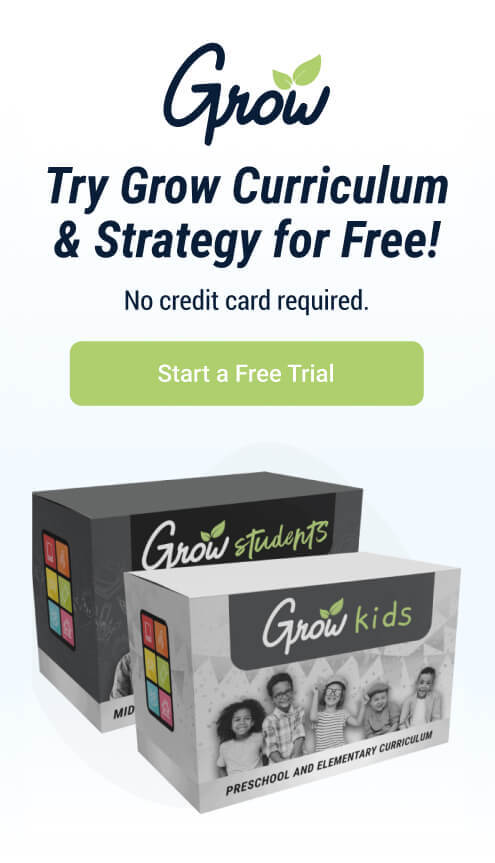You’ve got a brand new volunteer ready to step into your ministry. Congratulations! All the time you’ve spent networking and connecting with people has paid off.
But now what?
What do you tell them? Where do you start training them? What’s the most important piece of information you could give them to successfully integrate into your ministry?
Sometimes, we make it harder than necessary to get our volunteers up and running. That’s one of the reasons why it’s so important to have a volunteer strategy each and every year (and if you don’t have one yet, feel free to steal ours!) If we don’t prepare in advance for how we want to train, connect with, and lead our volunteers, we’ll have a rough time onboarding anyone new.
One of the most important pieces of your volunteer strategy is the Volunteer Handbook. It covers so much about your ministry and vision, so it’s an essential part of helping volunteers do their jobs well. But if you’ve never put together a Handbook, you might not know exactly where to start. What’s the important stuff? What can I leave out? What should live on a need-to-know-basis? If you have those questions (or any others), we’re here to help!
Here’s what you should include inside your Volunteer Handbook.
WHAT TO INCLUDE IN YOUR VOLUNTEER HANDBOOK
1. A WELCOME
Like a good book, Volunteer Handbooks should start with a short introduction to help your volunteers get situated. Greet them as they read and give them a simple view of why their work will be so important to kids, teenagers, and their parents.
2. THE BASICS
Next up, give your volunteers some basic information about your ministry. Be sure to include …
- YOUR STAFF: You’ll want to include a list of all of your staff members complete with a head shot, titles, and contact information. Give a simple, fun job description for each person. This section will help your volunteers start to understand a bit about your role at your church and give some insight into your personality. Plus, it gives them an easy, memorable place to find out how to contact you in case they forget.
- YOUR MINISTRY LOGISTICS: Inside this section you’ll want to include all of the information about your weekly programs — time, location, and a little bit about what happens during each of your programs. For kids, this might be include information about preschool and elementary programs, while youth pastors might include middle school and high school programs.
- YOUR MINISTRY ENVIRONMENTS: On top of your weekly meeting information, you’ll want to give a short summary of your environments. How do you connect and do ministry with kids and students? What’s your plan or strategy for events? How do your weekly programs work to disciple kids and teenagers? What’s the point of small groups? How else do you connect with and disciple kids and teenagers? Give your volunteers just a short snapshot of what you do throughout the year and why you do it.
3. YOUR STRATEGY
This section is probably the most important section for your volunteers. It gives them insight into the heart of your ministry and how you approach leading kids and teenagers in relationship with Jesus. Don’t be afraid to make this section the longest part of your Handbook because it’s really, really important to be clear about your vision and strategy. (And if you don’t have a solid ministry strategy yet yet, take a look at how you can start building your strategy for kids ministry). It’s helpful for you because you get to communicate why your ministry functions the way it does, and it’s helpful for volunteers as they adjust and see their role in supporting the vision for your ministry.
In this section you’ll want to talk about what your goals are for your students and how you hope to lead them through these goals. This isn’t just “We want kids to know Jesus” but also “Here are the things we focus on to help kids get to know Jesus.” If you’re using the Grow Strategy, you’ll know we focus on building four spiritual habits in kids and teenagers. We believe when people learn to spend time with God, spend time with others, use their gifts, and share their story, they can grow and build up their faith.
This is also a great time for you to unpack how you approach topics like discipleship or working with parents. How do these things connect with your vision, strategy, and the goals you have for the kids and teenagers in your ministry? It’s a lot of information to spell out, but the good news is you only need to do it once! From there, you can update and tweak your vision and strategy as needed.
4. VOLUNTEER ROLES
Inside of your Handbook, you’ll want to take time to unpack each of your Volunteer Roles. There are so many opportunities for people to serve in a ministry, but they may not always know about them. This is a great chance for you to spell out the goal for each role and what’s expected for people who serve in those spaces. It gives you and your volunteers a clear measure of expectations and standards which can be really helpful in future one-on-one conversations.
5. THE FINE PRINT
Policies and procedures might sound a little boring, but talking about them with your team is absolutely essential for leading a healthy ministry. You’ll want to include …
- SAFETY: Your job as a pastor is to help keep kids and teenagers safe. Your Volunteer Handbook is the best, most accessible way for you to inform your team of all of the safety guidelines for your ministry. Include information about physical boundaries, check-in and check-out procedures, your expectations for private and electronic conversations, how to report dangerous situations, and how to identify and define abuse. For kids, you’ll also want to include policies on changing diapers, food allergies for snacks, and discipline procedures. These are really important policies to consider and put into writing for your volunteers to stay informed and stay safe while working with kids and students.
- CODE OF CONDUCT: As you start to wrap up your Handbook, you should also include a section on Code of Conduct. What do you expect from every volunteer? What do you expect from more involved roles like Small Group Leaders? Don’t burden your team with expectations, but don’t let them do whatever they want, either. Hold reasonable, measurable expectations for your team to help them thrive together in ministry!
- COMMITMENT: Finally, wrap up your Handbook with a commitment page your volunteers can sign and turn in. Refer back to a few of the important elements from your Handbook like safety guidelines and the code of conduct. You’ll want volunteers to feel like they’re making serious commitment (because they are) but not like they’re signing their life away to serve as your minions and do your bidding.
That’s just about everything you should include inside of your Volunteer Handbook. Remember to clarify your vision, safety guidelines, and code of conduct for your volunteers and give this Handbook to them with the other tools they’ll need to do their jobs well.
And if you’re using Grow Curriculum, we’ve done a bulk of the work for you! Inside of every volume of Grow Kids and Grow Students, you’ll find a customizable Volunteer Handbook waiting for you. It’s designed around the Grow Strategy, and it includes all of the sections we’ve talked about today ready for you to edit, adapt to your ministry, and hand out to your volunteers!















In this post, here’s what we’ll cover: